YAMAHA GRIZZLY 450 2014 Owners Manual
Manufacturer: YAMAHA, Model Year: 2014, Model line: GRIZZLY 450, Model: YAMAHA GRIZZLY 450 2014Pages: 174, PDF Size: 3.99 MB
Page 121 of 174
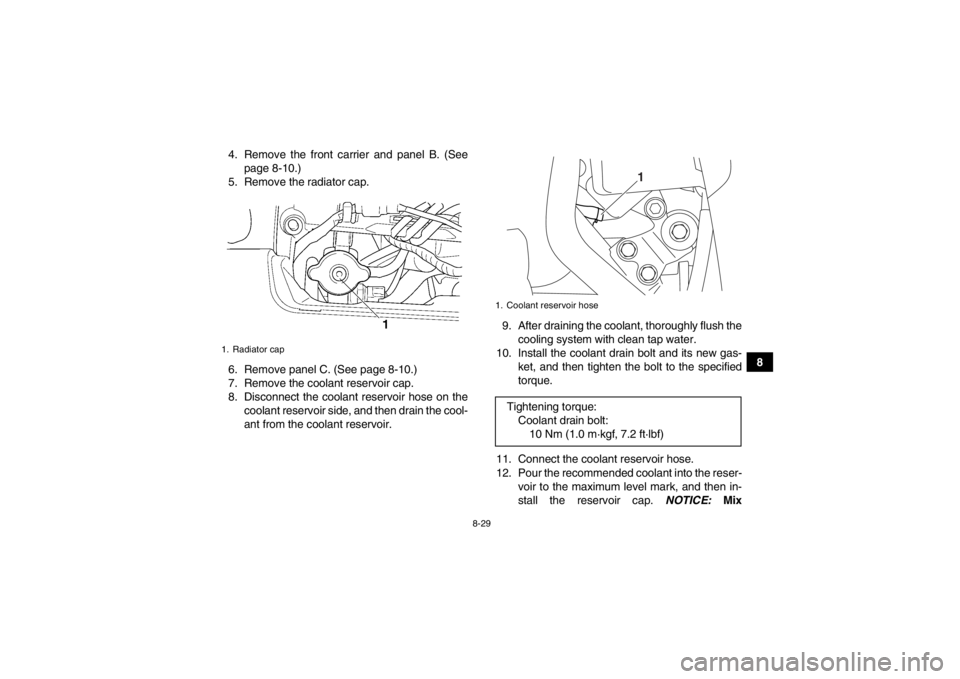
8-29
8
4. Remove the front carrier and panel B. (See
page 8-10.)
5. Remove the radiator cap.
6. Remove panel C. (See page 8-10.)
7. Remove the coolant reservoir cap.
8. Disconnect the coolant reservoir hose on the coolant reservoir side, and then drain the cool-
ant from the coolant reservoir. 9. After draining the coolant, thoroughly flush the
cooling system with clean tap water.
10. Install the coolant drain bolt and its new gas- ket, and then tighten the bolt to the specified
torque.
11. Connect the coolant reservoir hose.
12. Pour the recommended coolant into the reser- voir to the maximum level mark, and then in-
stall the reservoir cap. NOTICE: Mix
1. Radiator cap
1. Coolant reservoir hoseTightening torque:
Coolant drain bolt:10 Nm (1.0 m·kgf, 7.2 ft·lbf)
1
U2LC60E0.book Page 29 Friday, March 8, 2013 1:18 PM
Page 122 of 174
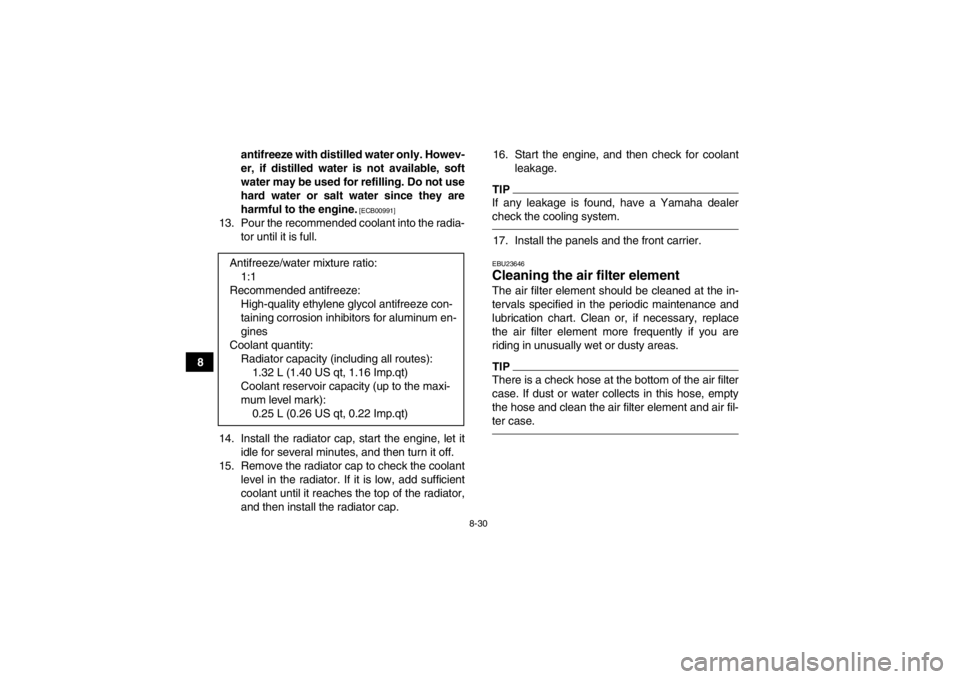
8-30
8antifreeze with distilled water only. Howev-
er, if distilled water is not available, soft
water may be used for refilling. Do not use
hard water or salt water since they are
harmful to the engine.
[ECB00991]
13. Pour the recommended coolant into the radia-
tor until it is full.
14. Install the radiator cap, start the engine, let it idle for several minutes, and then turn it off.
15. Remove the radiator cap to check the coolant level in the radiator. If it is low, add sufficient
coolant until it reaches the top of the radiator,
and then install the radiator cap. 16. Start the engine, and then check for coolant
leakage.
TIPIf any leakage is found, have a Yamaha dealer
check the cooling system.17. Install the panels and the front carrier.EBU23646Cleaning the air filter element The air filter element should be cleaned at the in-
tervals specified in the periodic maintenance and
lubrication chart. Clean or, if necessary, replace
the air filter element more frequently if you are
riding in unusually wet or dusty areas.TIPThere is a check hose at the bottom of the air filter
case. If dust or water collects in this hose, empty
the hose and clean the air filter element and air fil-
ter case.
Antifreeze/water mixture ratio:1:1
Recommended antifreeze: High-quality ethylene glycol antifreeze con-
taining corrosion inhibitors for aluminum en-
gines
Coolant quantity: Radiator capacity (including all routes):1.32 L (1.40 US qt, 1.16 Imp.qt)
Coolant reservoir capacity (up to the maxi-
mum level mark): 0.25 L (0.26 US qt, 0.22 Imp.qt)
U2LC60E0.book Page 30 Friday, March 8, 2013 1:18 PM
Page 123 of 174
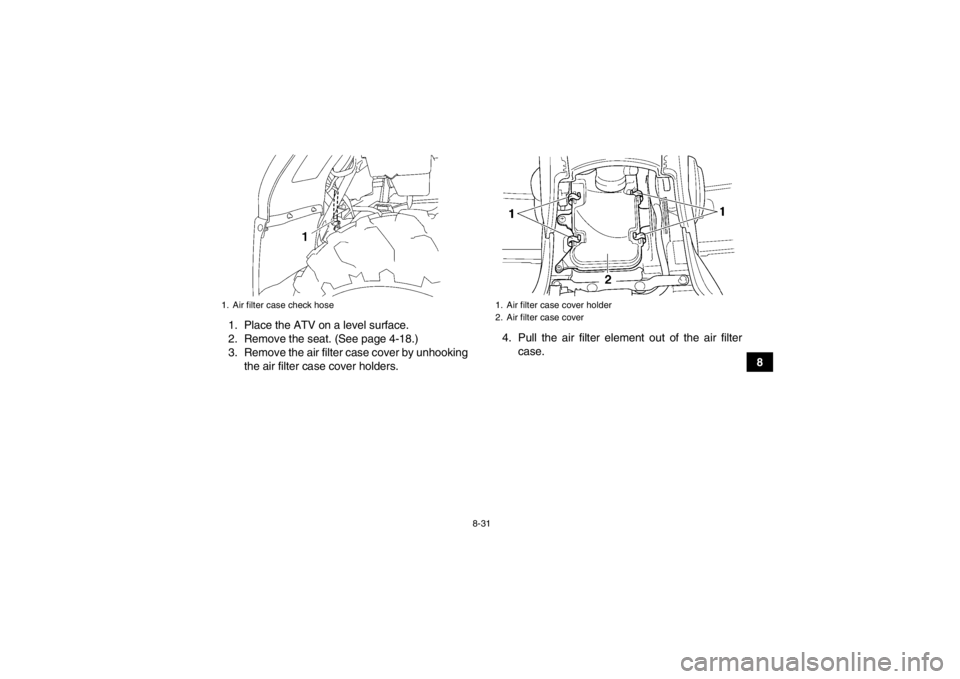
8-31
8
1. Place the ATV on a level surface.
2. Remove the seat. (See page 4-18.)
3. Remove the air filter case cover by unhooking
the air filter case cover holders. 4. Pull the air filter element out of the air filter
case.
1. Air filter case check hose
1. Air filter case cover holder
2. Air filter case cover
U2LC60E0.book Page 31 Friday, March 8, 2013 1:18 PM
Page 124 of 174
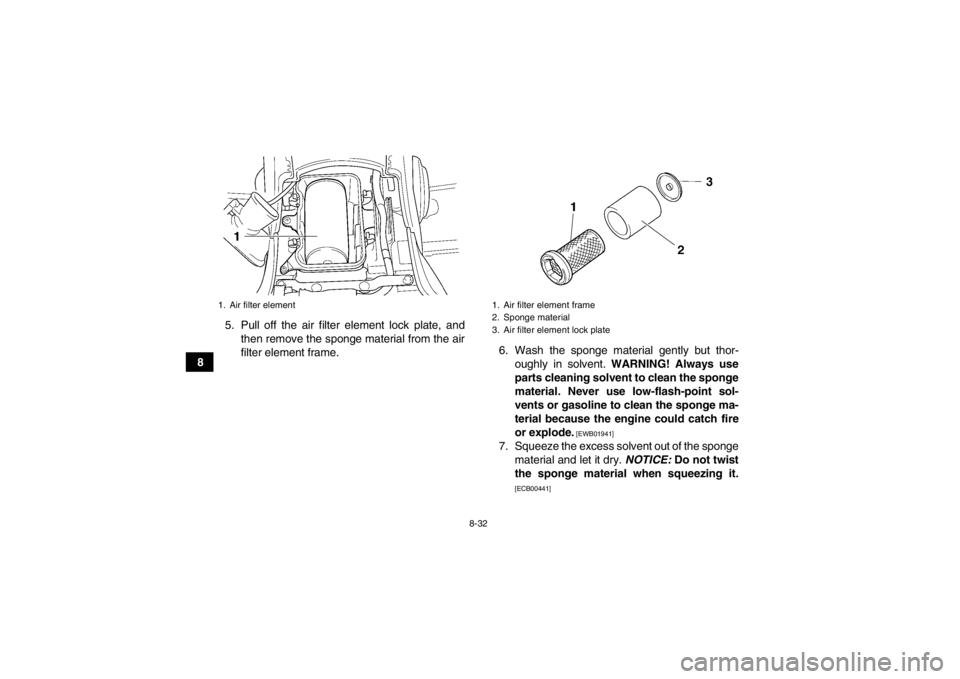
8-32
85. Pull off the air filter element lock plate, and
then remove the sponge material from the air
filter element frame. 6. Wash the sponge material gently but thor-
oughly in solvent. WARNING! Always use
parts cleaning solvent to clean the sponge
material. Never use low-flash-point sol-
vents or gasoline to clean the sponge ma-
terial because the engine could catch fire
or explode.
[EWB01941]
7. Squeeze the excess solvent out of the sponge material and let it dry. NOTICE: Do not twist
the sponge material when squeezing it.
[ECB00441]
1. Air filter element
1. Air filter element frame
2. Sponge material
3. Air filter element lock plate
U2LC60E0.book Page 32 Friday, March 8, 2013 1:18 PM
Page 125 of 174
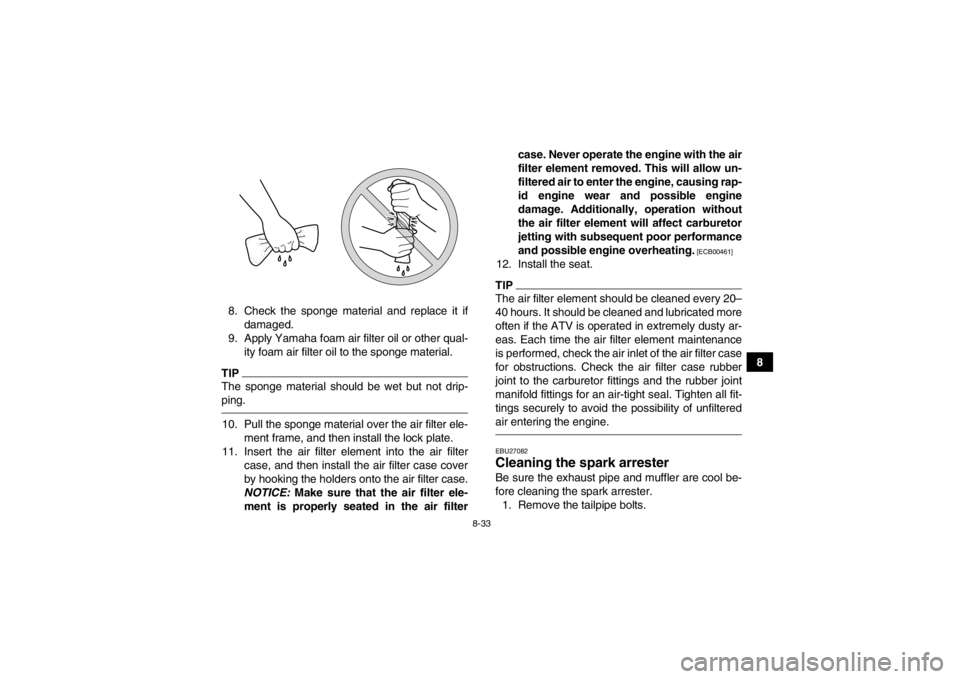
8-33
8
8. Check the sponge material and replace it if
damaged.
9. Apply Yamaha foam air filter oil or other qual- ity foam air filter oil to the sponge material.
TIPThe sponge material should be wet but not drip-
ping.10. Pull the sponge material over the air filter ele- ment frame, and then install the lock plate.
11. Insert the air filter element into the air filter case, and then install the air filter case cover
by hooking the holders onto the air filter case.
NOTICE: Make sure that the air filter ele-
ment is properly seated in the air filter case. Never operate the engine with the air
filter element removed. This will allow un-
filtered air to enter the engine, causing rap-
id engine wear and possible engine
damage. Additionally, operation without
the air filter element will affect carburetor
jetting with subsequent poor performance
and possible engine overheating.
[ECB00461]
12. Install the seat.TIPThe air filter element should be cleaned every 20–
40 hours. It should be cleaned and lubricated more
often if the ATV is operated in extremely dusty ar-
eas. Each time the air filter element maintenance
is performed, check the air inlet of the air filter case
for obstructions. Check the air filter case rubber
joint to the carburetor fittings and the rubber joint
manifold fittings for an air-tight seal. Tighten all fit-
tings securely to avoid the possibility of unfiltered
air entering the engine.EBU27082Cleaning the spark arrester Be sure the exhaust pipe and muffler are cool be-
fore cleaning the spark arrester.
1. Remove the tailpipe bolts.
U2LC60E0.book Page 33 Friday, March 8, 2013 1:18 PM
Page 126 of 174
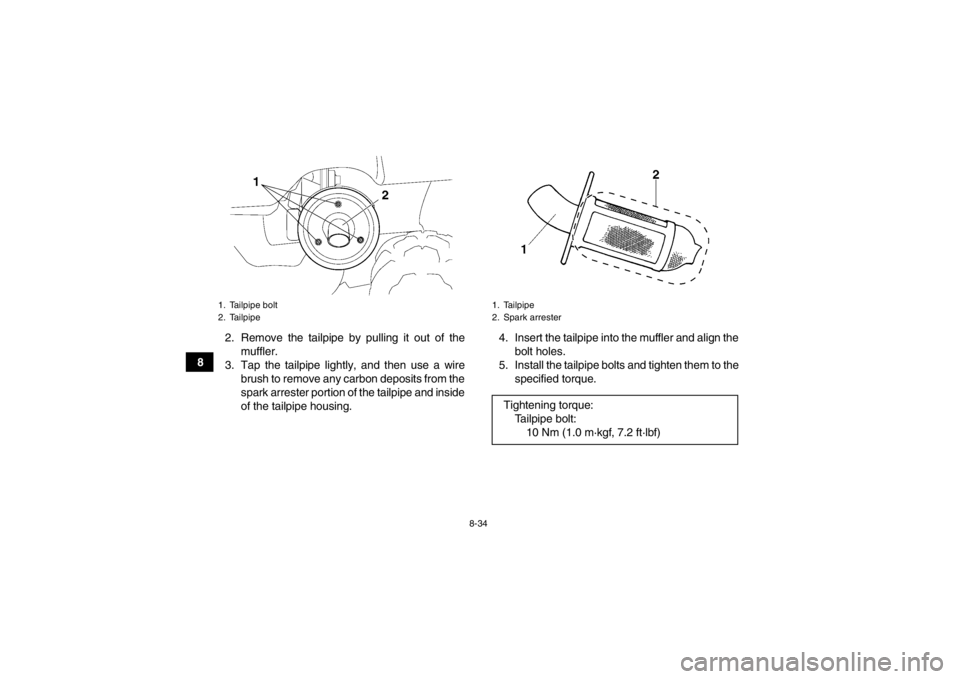
8-34
82. Remove the tailpipe by pulling it out of the
muffler.
3. Tap the tailpipe lightly, and then use a wire brush to remove any carbon deposits from the
spark arrester portion of the tailpipe and inside
of the tailpipe housing. 4. Insert the tailpipe into the muffler and align the
bolt holes.
5. Install the tailpipe bolts and tighten them to the specified torque.
1. Tailpipe bolt
2. Tailpipe
1. Tailpipe
2. Spark arresterTightening torque:Tailpipe bolt:10 Nm (1.0 m·kgf, 7.2 ft·lbf)
U2LC60E0.book Page 34 Friday, March 8, 2013 1:18 PM
Page 127 of 174
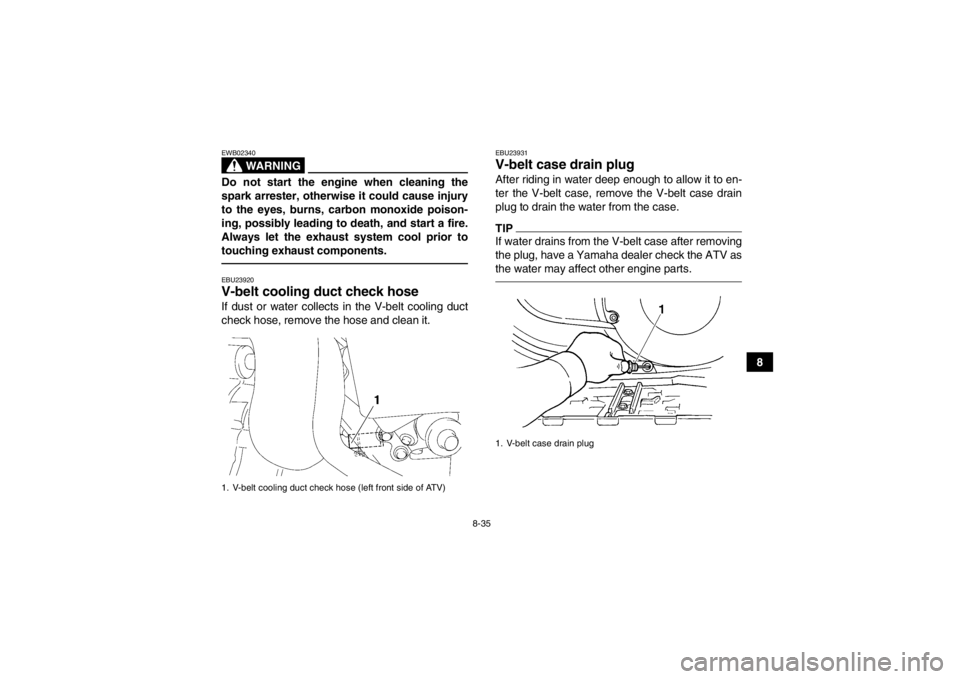
8-35
8
WARNING
EWB02340Do not start the engine when cleaning the
spark arrester, otherwise it could cause injury
to the eyes, burns, carbon monoxide poison-
ing, possibly leading to death, and start a fire.
Always let the exhaust system cool prior to
touching exhaust components.EBU23920V-belt cooling duct check hose If dust or water collects in the V-belt cooling duct
check hose, remove the hose and clean it.
EBU23931V-belt case drain plug After riding in water deep enough to allow it to en-
ter the V-belt case, remove the V-belt case drain
plug to drain the water from the case.TIPIf water drains from the V-belt case after removing
the plug, have a Yamaha dealer check the ATV as
the water may affect other engine parts.
1. V-belt cooling duct check hose (left front side of ATV)
1. V-belt case drain plug
U2LC60E0.book Page 35 Friday, March 8, 2013 1:18 PM
Page 128 of 174
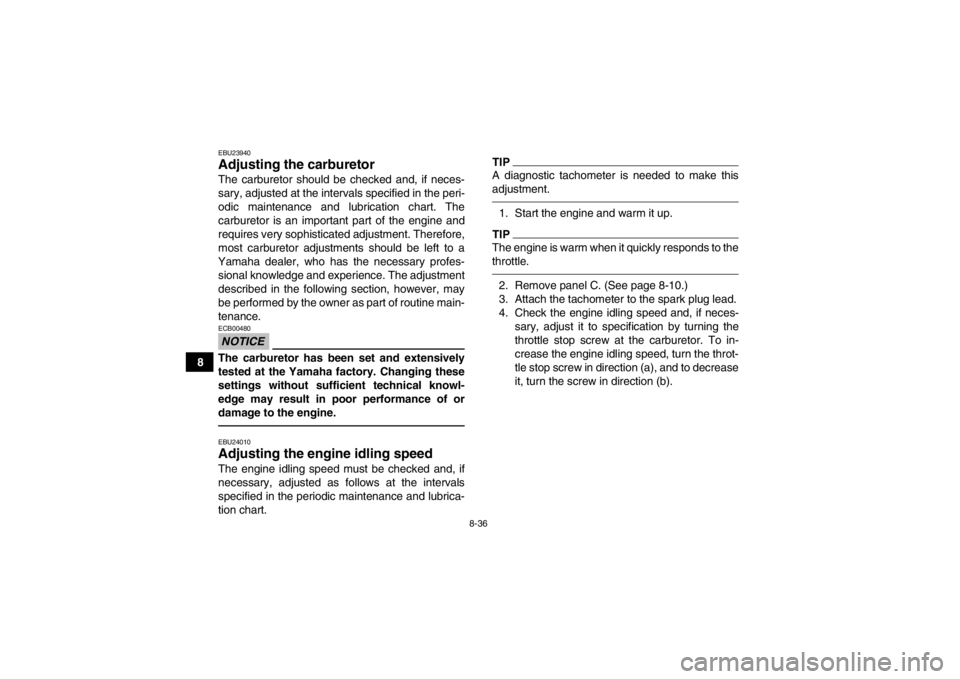
8-36
8
EBU23940Adjusting the carburetor The carburetor should be checked and, if neces-
sary, adjusted at the intervals specified in the peri-
odic maintenance and lubrication chart. The
carburetor is an important part of the engine and
requires very sophisticated adjustment. Therefore,
most carburetor adjustments should be left to a
Yamaha dealer, who has the necessary profes- sional knowledge and experience. The adjustment
described in the following section, however, may
be performed by the owner as part of routine main-
tenance.NOTICEECB00480The carburetor has been set and extensively
tested at the Yamaha factory. Changing these
settings without sufficient technical knowl-
edge may result in poor performance of or
damage to the engine.EBU24010Adjusting the engine idling speed The engine idling speed must be checked and, if
necessary, adjusted as follows at the intervals
specified in the periodic maintenance and lubrica-
tion chart.
TIPA diagnostic tachometer is needed to make this
adjustment.1. Start the engine and warm it up.TIPThe engine is warm when it quickly responds to the
throttle.2. Remove panel C. (See page 8-10.)
3. Attach the tachometer to the spark plug lead.
4. Check the engine idling speed and, if neces- sary, adjust it to specification by turning the
throttle stop screw at the carburetor. To in-
crease the engine idling speed, turn the throt-
tle stop screw in direction (a), and to decrease
it, turn the screw in direction (b).
U2LC60E0.book Page 36 Friday, March 8, 2013 1:18 PM
Page 129 of 174
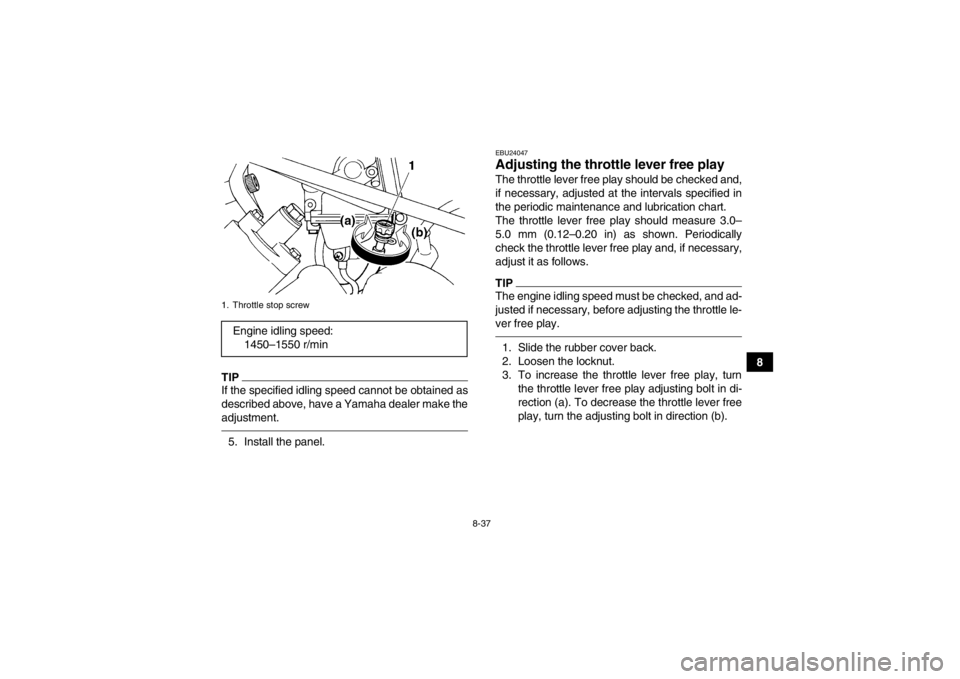
8-37
8
TIPIf the specified idling speed cannot be obtained as
described above, have a Yamaha dealer make the
adjustment.5. Install the panel.
EBU24047Adjusting the throttle lever free play The throttle lever free play should be checked and,
if necessary, adjusted at the intervals specified in
the periodic maintenance and lubrication chart.
The throttle lever free play should measure 3.0–
5.0 mm (0.12–0.20 in) as shown. Periodically
check the throttle lever free play and, if necessary,
adjust it as follows.TIPThe engine idling speed must be checked, and ad-
justed if necessary, before adjusting the throttle le-
ver free play.1. Slide the rubber cover back.
2. Loosen the locknut.
3. To increase the throttle lever free play, turnthe throttle lever free play adjusting bolt in di-
rection (a). To decrease the throttle lever free
play, turn the adjusting bolt in direction (b).
1. Throttle stop screwEngine idling speed:1450–1550 r/min
U2LC60E0.book Page 37 Friday, March 8, 2013 1:18 PM
Page 130 of 174
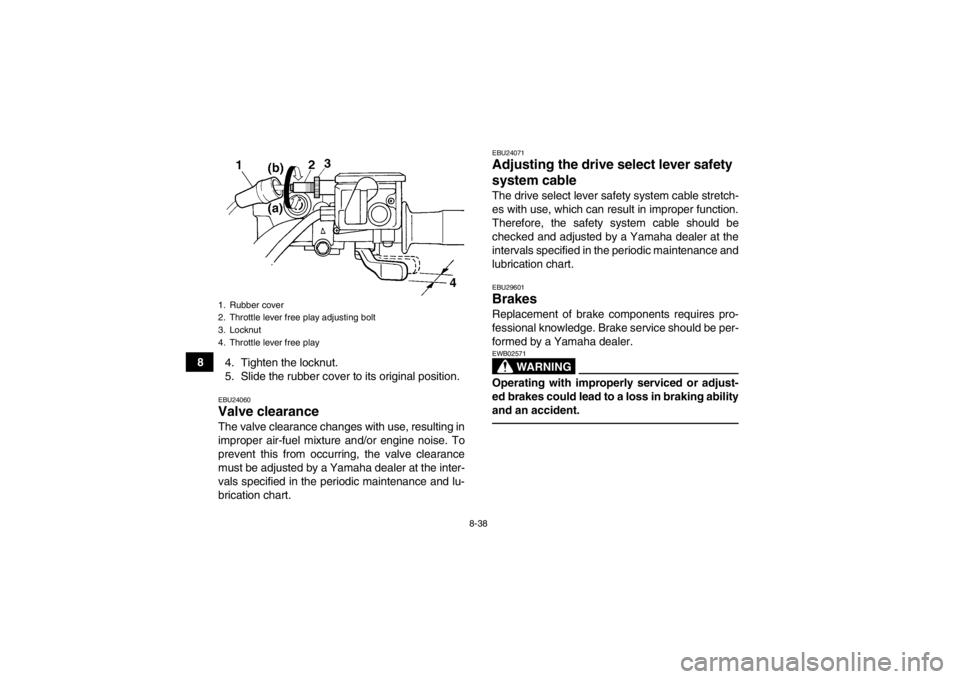
8-38
84. Tighten the locknut.
5. Slide the rubber cover to its original position.
EBU24060Valve clearance The valve clearance changes with use, resulting in
improper air-fuel mixture and/or engine noise. To
prevent this from occurring, the valve clearance
must be adjusted by a Yamaha dealer at the inter-
vals specified in the periodic maintenance and lu-
brication chart.
EBU24071Adjusting the drive select lever safety
system cable The drive select lever safety system cable stretch-
es with use, which can result in improper function.
Therefore, the safety system cable should be
checked and adjusted by a Yamaha dealer at the
intervals specified in the periodic maintenance and
lubrication chart.EBU29601Brakes Replacement of brake components requires pro-
fessional knowledge. Brake service should be per-
formed by a Yamaha dealer.
WARNING
EWB02571Operating with improperly serviced or adjust-
ed brakes could lead to a loss in braking ability
and an accident.
1. Rubber cover
2. Throttle lever free play adjusting bolt
3. Locknut
4. Throttle lever free playU2LC60E0.book Page 38 Friday, March 8, 2013 1:18 PM